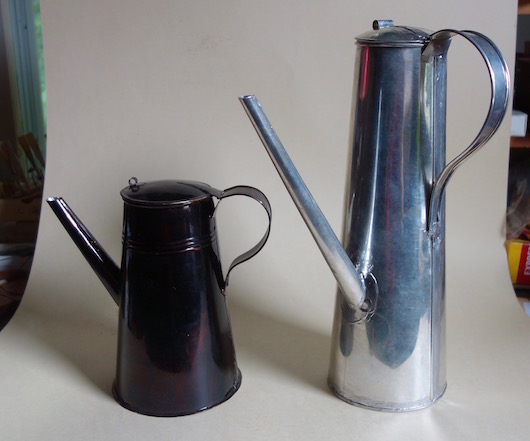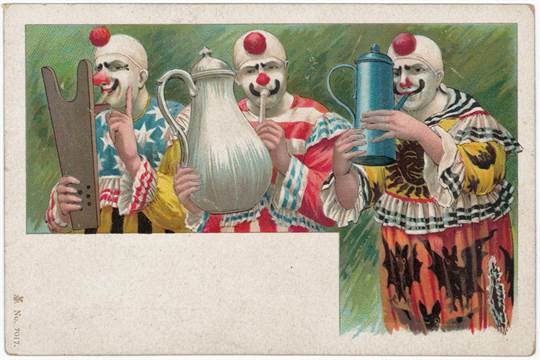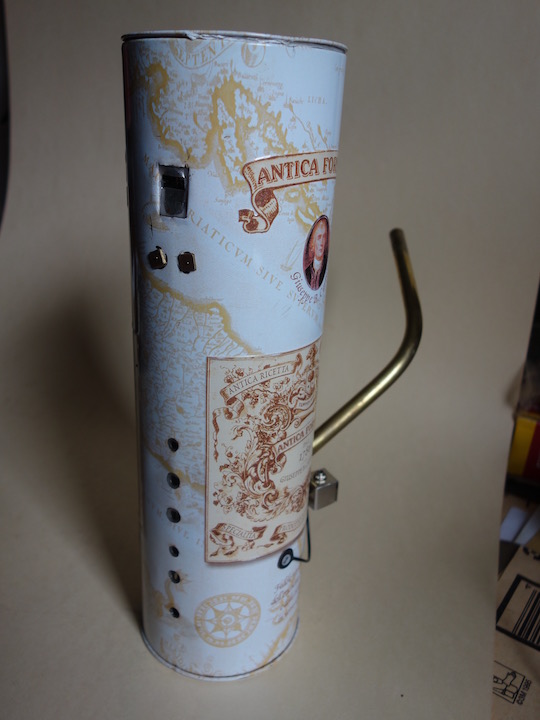The Coffeepot

A tin beverage coffeepot of recent make on left. Musical coffeepot on right.

A postcard, unknown date or publisher location, brought to my attention by Alex DeWilde, Sep. 2016. He found the image on the Web, www.the-saleroom.com, from United Kingdom.
The coffeepot was a "clown instrument," a pennywhistle tucked inside what looked like an old-fashioned coffeepot. The effect is primarily visual; the whistle sounds much the same as it would without the surrounding pot.
The instrument was used by clowns, buskers (street musicians) and a few vaudeville performers in USA, England, France. Earliest reference I have found is from 1863. Latest reference to a performance is from 1896.
Based on the postcard image and most, but not all, of the written descriptions, the instrument's look was taken from a common tinware design for a beverage coffeepot which was in use at least before the US Civil War. Beverage coffeepots like this are still being made, many for use by historic re-enactors; those who dress as Civil War soldiers, for example.
The best description of the coffeepot was written by Francis O'Neill in his book Irish Minstrels and Musicians (1913) where he describes the activities of Thomas F. Kerrigan, an Irish (uilleann) bagpiper, probably around 1890:
- On the stage [of his saloon in New York City] Kerrigan played the pipes to the accompaniment of a piano from four to six o'clock every afternoon. He varied this, however, with an occasional tune on the "coffeepot." This clown instrument consists of a tall, rather slim coffeepot, with a teapot-like spout on the side. Holes are punched in the tin opposite the spout, to correspond with the holes of a tin flageolet soldered within. The player blows through the spout, and fingers the tune on the holes in the coffeepot.
Henry Liskard, an English clown active circa 1863-1883, claimed to have invented the coffeepot, along with other improbable instruments. "Then came my musical coffee pot, which I daresay you have seen men playing at street corners heaps of times. It is very simple, a tin whistle soldered into the side of a coffee pot and connected with the spout. I first played that in Charles Hengler's Circus...."
American vaudeville performers include J. Lowery; The Tyrolean Whistler; Dan Dougherty; Dan Nash. For these players, the coffeepot was usually but one of many instruments they used in their performances.
As far as I can tell none of these instruments survive. If such a one exists, in museum or in private hands, I would be happy to know about it. Inspired by the postcard image, above, I made a few prototypes from tall tin cans (for more about this, see bottom of this page). Based on my design Nick Lawler, a friend, made a coffeepot in 2017. I am the proud owner. Here is a YouTube video of me playing on it.
Below are all the references I have found to the musical coffeepot.
-----
Brooklyn, NY Hooley's Opera House Nov. 1863
"Hooley, at Court and Remsen Streets, was in full flower in September, 1863.... At Thanksgiving time, Griffin put on his act, Smoke, and J. Lowrey performed his Coffee Pot solos. ..."
Annals of the New York Stage by George C. D. Odell, Columbia Univ. Press 1931 vol. VII p. 620.
-----
NYC Barnum's American Museum Feb. 21?-27?, 1864
"... every afternoon and evening this week ... appears at each performance ...
"THE TYROLEAN WHISTLER,
"on his three whistles at once, and on the Tyrolean Family Coffee-Pot."
New-York Times Feb. 23, 1864 p. 7 column 5 ad+
Newspapers.com
https://www.newspapers.com/image/20669573
-----
"Street Music.-A new street prodigy has made his appearance in Paris in the shape of a lad, who discourses excellent music on three common tin whistles, using each alternately, and without any break of tune. He then astonishes his audience by playing a variety of tunes on the spout of a coffee pot. The lid is partially raised and there are holes in the body of the pot which the fingers cover. So far the professor has found his peculiar accomplishment a very paying one. He will have to make hay while the sun shines, for no doubt the idea and its success will cause his ingenious brethren to see whether music cannot be knocked out of other articles of domestic utility, and then his occupation will be gone."
Daily Milwaukee [WI] News Nov. 20, 1866 p. 2 column 4
Newspapers.com
https://www.newspapers.com/image/7624687
-----
"Dan Dougherty-Serio-Comic Singing, plays on a Coffee Pot, imitating Scotch and Irish Pipes; also Cornet and Trombone, imitating Army Calls, Flute Solos and Six Flageolets at the same time."
From an ad listing performers represented by Col. T. Allston Brown's Dramatic, Musical, Minstrel, Equestrian and Variety Hall Agency.
New York Clipper Nov. 26, 1870 p. 267 column 3 ad+
Illinois Digital Newspaper Collections
http://idnc.library.illinois.edu/cgi-bin/illinois?a=d&d=NYC18701126.2.30&srpos=12&e=-------en-20--1--txt-txIN-%22irish+pipes%22------#
-----
Decatur, IL Opera House Nov. 11-12, 1874
'[Frank] McEvoy's [New] Hibernicon.-This entertainmen drew a full house, and right well did the performance deserve it. ... Lawlor, as "Barney, the Guide," was immence, as were also E. Donahue and [Dan] Nash with their songs and Irish shillalah.... The performances of Nash, with his tin whistles and coffee-pot, were truly wonderful, and brought down the house with thundering applause.'
Decatur IL Daily Republican Nov. 12, 1874 p. 3 column 2
Newspapers.com
https://www.newspapers.com/image/31680973
Ad this show:
Decatur IL Daily Republican Nov. 11, 1874 p. 2 column 5
Newspapers.com
https://www.newspapers.com/image/31680968
-----
Memphis, TN Assembly Hall Dec. 20, 1875
'Hibernicon.-MacEvoy's Hibernicon and troupe appeared before a large audience at the Assembly Hall last evening. ... Mr. Nash amused the audience with his side-splitting imitation of the bagpipes on an old coffee-pot, while he charmed them by his brilliant execution of the "Carnival of Venice" on a ten cent tin whistle.'
Memphis TN Public Ledger Dec. 21, 1875 p. 2 column 4
Newspapers.com
https://www.newspapers.com/image/171550536
-----
NYC Tony Pastor's Theatre? May 22-27?, 1876
City Summary.
'Miss Mina Geary, Dan Nash, the Landis Brothers, Jennie Engle, and the Foy Sisters were the additions to Tony Pastor's company on May 22. Mina Geary and Dan Nash performed a musical sketch called "The Irish Emigrant's Lament," which is one of the most effective that we have witnessed in a long time. Both are good vocalists.... During the progress of the sketch, Mr. Nash performed quite skillfully upon two tin whistles, alternating them quite rapidly without marring the time of the melody, and subsequently gave a clever imitation of the Irish pipes, using as an instrument a huge tin coffee-pot. Earlier in the evening Mr. Nash's excellent tenor voice was heard in new popular songs, he being attired in full evening-dress.'
New York Clipper June 3, 1876 p. 78 column 3
Illinois Digital Newspaper Collections
http://idnc.library.illinois.edu/cgi-bin/illinois?a=d&d=NYC18760603.2.81&e=-------en-20--1--txt-txIN-%22irish+pipes%22------#
Account of another gig, at St. Columba's Irish School, NYC, Sep. 23, 1880, says "Mr. Dan Nash appeared in his Irish character songs, and his imitation of the Irish bagpipes, upon a common coffeepot, was encored amid deafening applause."
NY Irish-American Oct. 2, 1880 p. 8 column 3
GenealogyBank.com
-----
Queer Occupations.
From the London Globe.
'Many of the "odds-and-endists," like the nut-counter, are ministers of some slight amusement for the public. One of these wanderers used to stand in by-streets and draw sweet music from a tin coffee-pot. This quaint instrument was pierced with holes, the musician blew into the spout, and skilfully governed the "vertages" with his finger.'
New-York Daily Tribune Feb. 25, 1883 p. 4 column 4
Newspapers.com
https://www.newspapers.com/image/85651812
-----
Bloomfield, NJ Spragg's Building Jan. 9?, 1884
Excelsior Lodge, K. of H.
"Excelsior Lodge, K. of H., No. 2,342, observed their installation ceremonies in a public manner, on Wednesday evening. ... George Jordon, of Newark, gave several selections on the tin whistle and coffee-pot spout, which are interesting instruments, when brillaintly handled, as they were on this occasion."
Bloomfield [NJ] Citizen Jan. 12, 1884 p. 1 column 5
Fulton History index
Bloomfield NJ Citizen 1883-1886 - 0149.pdf
-----
State News.
'David Jourdan, of Newark, young, but a veteran performer on the tin whistle, has issued a challenge to all rivals in New Jersey to contest with him for the State championship and a stake of either $100 or $200 a side. It is said he plays "I Dremt that I Dwelt In Marble Halls" very sweetly on a tin coffee pot, which has perforations in various parts and whose tones resemble those of a small organ.'
Paterson [NJ] Daily Guardian Feb. 23, 1884 p. 1 column 4
Fulton History index
Paterson NJ Daily Gardian 1883 Sep-Mar 1884 - 0627.pdf
-----
A Musical Instrument Faker.
An Interview with Harry Liskard
Reproduced, together with the illustrations, by kind permission of the Pall Mall Gazette.
' "Then came my musical coffee pot, which I daresay you have seen men playing at street corners heaps of times. It is very simple, a tin whistle soldered into the side of a coffee pot and connected with the spout. I first played that in Charles Hengler's Circus...." '
The British Bandsman April 1889 vol. II no. 19 pp. 150-151
Google Books.
https://books.google.com/books?id=rqwaAQAAMAAJ&pg=RA1-PA150&lpg=RA1-PA150&dq=%22tin+whistle%22+coffee+pot&source=bl&ots=5aJWZYOJK2&sig=KkcGybdNPUKwRbArLHUigjKqYyQ&hl=en&sa=X&ved=0ahUKEwjZyfi1wZ_QAhWq4IMKHcMMAUIQ6AEIQTAK#v=onepage&q&f=false
Interesting account of Liskard, who invented several imaginative musical instruments and performed as a clown, circa 1863-83. Apparently from London; performed in Great Britain, Europe, U.S. Known professionally as a "musical momus." A Google search for "musical momus" and "Liskard clown" will return some results.
-----
"On the stage [of his saloon in New York City, Thomas F.] Kerrigan played the pipes to the accompaniment of a piano from four to six o'clock every afternoon. He varied this, however, with an occasional tune on the "coffeepot." This clown instrument consists of a tall, rather slim coffeepot, with a teapot-like spout on the side. Holes are punched in the tin opposite the spout, to correspond with the holes of a tin flageolet soldered within. The player blows through the spout, and fingers the tune on the holes in the coffeepot." Circa 1890
O'Neill, Francis Irish Minstrels and Musicians 1913 p. 261
Uilleann pipemaker Matt Kiernan, in comments aired on radio show "The Long Note," RTE, 1982, says that his father told of seeing Kerrigan playing the coffeepot at "the Pleasant Hour House in New York."
Comments begin about 5:25 minutes in.
-----
Street Musicians.
Some Novelties of the Traveling Vendors of Harmony.
From London Tid-Bits.
"... a worthy who has constructed a gigantic and somewhat bulky tin whistle out of a coffee-pot. He has made holes down the body of the pot, and uses the spout as a mouthpiece. We hasten to credit another gentleman with making a similar instrument out of an ordinary teakettle."
Philadelphia PA Times Sep. 4, 1892 p. 18 column 6
Newspapers.com
https://www.newspapers.com/image/52587271
-----
'I used rather, to pride myself on being able to spot a man's trade or profession by a good look at his exterior. I had the advantage of studying under a master of the art.... "Well, my man," I have heard him say: "I can see by your fingers that you play some musical instrument for your livelihood, but it is rather a curious one-something quite out of my line." The man afterwards informed us that he earned a few coppers by blowing "Rule Britannia" on a coffee pot, the spout of which was pierced to form a rough flute."
Doyle, A. Conan, "Recollections of Captain Wilkie" copyright 1895.
Milwaukee WI The Newspaper Library vol. VII no. 2 Feb. 1895 p. 1 column 1
Newspapers.com
https://www.newspapers.com/image/36377781
-----
"Military manoeuvers" a painting by Richard Thomas Moynan, 1891, presently in the National Gallery of Ireland [Museum inv. no.: NGI. 4364]. "A group of boys, pretending to be soldiers. Some play real or pretend instruments: a penny whistle ... a metal coffee pot blown throught the spout as a cornet or trumpet...."
Description from the Repertoire International d'Iconographie Musicale (RIdIM) website.
http://db.ridim.org/display.php?ridim_id=3165
NGI image:
http://onlinecollection.nationalgallery.ie/view/objects/asitem/People@1831/2?t:state:flow=7a71e178-e65d-41c6-b54b-479ef9b40174
-----
Street Musicians.
By Gilbert Guerdon.
"[Of a poor fiddler of London:] It was an accident that made him take to the tin whistle, or the "American flageolet," as he calls it. Bad luck had compelled him to pawn his fiddle.... He did not, however, make much of his playing till he had the whistle soldered on to a tin coffee-pot, in place of the spout. This took immensely, and the coffee-pot brought in more pence than the fiddle, sometimes as much as eight or nine shillings a day."
Strand Magazine Jan.? 1892 p. 64
Google Books
a href=https://books.google.com/books?id=1BxJAQAAMAAJ&pg=PA64&lpg=PA64&dq=coffeepot+tinwhistle&source=bl&ots=wukag-fCoM&sig=JwEgbClg8Q0svGH7ZtFzGTBdCdQ&hl=en&sa=X&ved=0ahUKEwikoOaAg6LPAhWKdT4KHc5GAywQ6AEIJDAC#v=onepage&q=coffeepot&f=false
-----
Gardner, MA Citizens' Hall Feb. 1896
Gardner.
Items of News About Town.
Mock Town Meeting.
"The Rev.[?] Reese association drew out a crowded house to its mock town meeting in Citizens' hall and cleared a good sum. Before the program there were piano selections by Mrs. John Cossaboom. The Messrs. Adkins and Batt gave their musical sketch in which they played tunes on ink bottles, pump, candle stick, coffee pot, hose pipe, vasaline bottle, etc."
Fitchburg [MA] Daily Sentinel Feb. 6, 1896 p. 5 column 3
Newspapers.com
https://www.newspapers.com/image/65408597
-----
Points of View. [by C. M. S.]
"Bell ringing as a serious performance was given over years ago. It is to be heard nowdays only in the variety shows and is generally a mere incident where tramps play on tumblers, brooms, paving rammers, coffee pots and other impossible objects."
Brooklyn [NY] Daily Eagle April 15, 1900 p. 20 column 6
Newspapers.com
https://www.newspapers.com/image/50387297
-----
Don't confuse this with kazoo bands, which sometimes had coffeepots or other utensils attached to the end of a kazoo.
'Basically, coffee-pot bands consisted of teenagers performing the music of their contemporary heroes, such as Duke Ellington, Cliff "Ukulele Ike" Edwards [etc.]....
'The coffee pot was used as an echo chamber for a kazoo; by blowing kazoos into the pots, you could simulate a whole reed section. Jerry Daniels said that "the larger the coffee pot, the more resonant the tone." '
Marv Goldberg More than Words Can Say: the Ink Spots and Their Music
Scarecrow Press 1998
See also article about the Kitchen Kabinet Band, Popular Mechanics Aug. 1927 pp. 235-37
Google Books
https://books.google.ie/books?id=ltgDAAAAMBAJ&pg=PA235&lpg=PA235&dq=The+Kitchen+Band+kazoo&source=bl&ots=KEcLBro54d&sig=sB-ejbfb3gRgmPfA_IwezII8Pvg&hl=en&sa=X&ved=0ahUKEwj9vLmVysnPAhVEIsAKHQ-OBB4Q6AEIHjAB#v=onepage&q=The%20Kitchen%20Band%20kazoo&f=false
-----
Postscript - the Tin Can Whistle

My coffeepot prototypes were made from tall tin cans, most of them containers for expensive beer or liquor bottles. To my surprise I found that briskly closing the finger holes when playing would produce percussive sounds. I play mostly Irish traditional dance music. The rhythms of the percussive sounds were sometimes in line with what a bodhran (Irish drum) player might do, sometimes not. Occasionally the rhythms were more syncopated or disorganized than a staunchly traditionalist player might want to hear. The sounds are not loud, more apparent to the player than the listener. Attach a pickup, though, and it is a different story. Here is a YouTube video of me playing on a tin can whistle with a pickup and amplifier.
Nick Whitmer
nwhitmer@livesofthepipers.com
September 2017